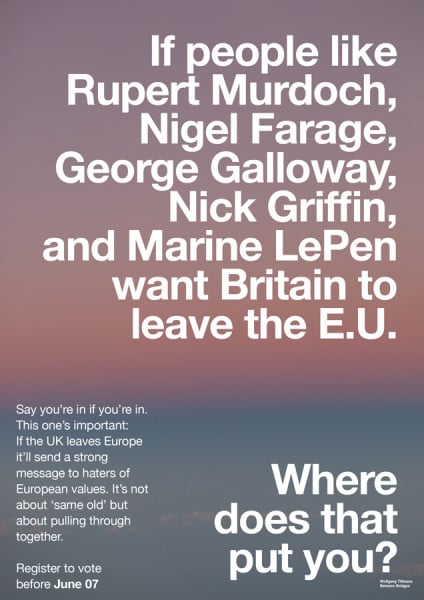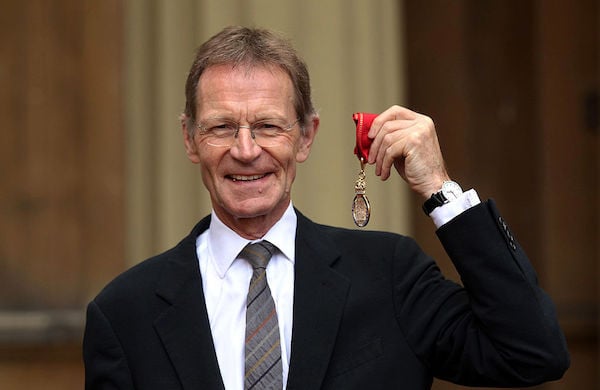Analysis
How Would Brexit Affect the British Art Market?
Artists, museum directors, gallerists, and other art experts have their say.

Artists, museum directors, gallerists, and other art experts have their say.

Laura Chesters

With the June 23 referendum—in which British citizens will decide whether they want to leave or stay in the EU—just three weeks away, the lines have been drawn ahead of this battle for Britain’s future in every corner of life, from the NHS, immigration, and the economy to security, mobile phones, and farming.
But, is Brexit a major concern for people in the art world or something they should vote for? Economics is not a science, and either side of the referendum debate are using predictions, not proven facts, about what may or may not happen if the UK were to leave.
So for the art market, what is there to lose or gain ahead of the referendum vote?

Tracey Emin is supporting the Stronger In Europe campaign.
Photo: Piers Allardyce via Wikimedia Commons.
Artists
Prominent figures feel strongly about keeping Britain in the EU: British artist Tacita Dean says Brexit fills her “with cold dread,” while artists Anish Kapoor, Tracey Emin, and Conrad Shawcross are among 282 well-known figures from the world of art and culture who have signed up to the Britain Stronger In Europe campaign.
The Berlin-based artist Wolfgang Tillmans, who developed his career and found fame while living in London, has gone as far as creating posters and letters to support keeping Britain in the EU.

A pro-EU poster by Wolfgang Tillmans.
Why? One of the major reasons is funding.
EU funding reaches millions of pounds each year and countless galleries and museums up and down the country have benefitted, as well as individual artists. Antony Gormley’s monumental Angel of the North, for example, was paid for by EU money, making the Vote Leave campaign slogan projection on to it recently somewhat ironic.
“Brexit supporters would likely respond to this by pointing to the money which arguably might be saved by leaving the EU, although there is no guarantee that this would be spent on the arts especially in the current climate of cuts to cultural funding,” Becky Shaw, an art law specialist at firm Boodle Hatfield, told artnet News.
Some big names may have come out in support of remaining, but others are unhappy with what they see as unnecessary EU legislation that has hurt the British industry, and think it would be better to be out.
The implementation of the artist’s resale right (ARR) scheme in 2006, for example, was welcomed by artists, but not by the rest of the industry.
The EU legislation entitles creators of original works of art to a royalty every time one of their works is resold for more than €1,000. It is levied at 4 percent on sale prices between €1,000 and €50,000, reducing to 0.25 percent on prices of more than €500,000. It is also paid to heirs for 70 years after an artist’s death.
But critics argue it puts London at a severe disadvantage against its biggest rivals New York and Hong Kong where it has not been introduced.
Anthony Browne, chairman of the British Art Market Federation, which lobbied against it ahead of its introduction, described it as the “single most awkward thing that the EU did to the art market.”
However even if the UK leaves the EU there is no way of knowing if ARR would be repealed, and even if it were, how quickly it could happen?
And yet, despite the uncertainty, artists still believe in the power of London as a global art hub, strong enough to withstand any changes.
Australian artist Penny Byrne, who is represented by the Bristol and London based gallery Coates & Scarry, presented her life size bronze sculpture Felled at London’s Art16 last month.
Byrne says she can see both sides of the argument but admits that the outcome will “not impact on my decision to show my work in London.” She adds: “For me London is the beating heart of the international arts world. I will always seek to show my work here.”

Tate Director Nicholas Serota.
Photo: Sean Dempsey – WPA Pool/Getty Images.
Museums and institutions
The directors of two of Britain’s best known museums have also spoken out in support for the Stronger In Europe camp.
Tate director Sir Nicholas Serota told the Times last month he is concerned about the possibility of Brexit, saying: “Art in Britain has always been influenced by what’s happening on the Continent; by the regular passage of artists—from Rubens through Van Dyck or Canaletto—backwards and forwards. So we are very much part of Europe.”
Meanwhile, Martin Roth, the German director of London’s Victoria & Albert Museum, warned London could lose out to Berlin if it left the EU, saying Brexit would be a “disaster” and explaining that the “European subsidies devoted to research will be greatly missed … I would imagine that Berlin will gain significant importance if London loses influence.”

V&A Director Martin Roth warned against “Brexit.” Photo: ROBERT MICHAEL/AFP/Getty Images.
But it is not just funding from the EU.
The export licence system, launched in 1993, allows museums to purchase works deemed of national importance at the same price they have been sold for. Jane Austen’s ring and a self-portrait by Sir Anthony Van Dyck which now hangs in the National Gallery are items that have been purchased in this way.
But critics claim it just adds further bureaucracy and costly administration to sales compared with competing nations around the world.
Dealers and galleries
Those against Brexit, talk of the uncertainty that leaving could mean for the economy. Various international economic institutions have warned of the impact on the economy, the weakening of investment into the UK, and even recession. Chancellor George Osborne announced Brexit would leave each British family worse off to the tune of £4,300 a year.
But those backing the Leave vote believe the EU has only held back the art sector.
Viscountess Bridgeman, founder of fine art image library Bridgeman Images, says: “Britain has a successful arts and cultural scene, and freed from the shackles of EU law and efforts to subsume it into a European brand it can only thrive.”
She says the art market would be better off if Britain were to leave and explains:
“The EU paid the UK £11.1 million in 2014 for ‘Creative Europe’ or 0.06 percent of the UK’s total contribution to the EU in the same year. The British Council received just over £30 million, or 0.18 percent of the UK’s total EU contribution. The UK received less from ‘Creative Europe’ funds than any other country, including France which received £44.2 million; Belgium, which received £32.1 million; or Germany, which received £20.4 million.”
“By paying into the EU nearly £20 billion per annum, we pay into the EU twice as much as we get back, and we have been net contributors for over 40 years – a total of over £508 billion!,” she added, arguing that Britain would “easily be able to match the EU’s funding, not only that, the arts could argue for more.”
Another crucial aspect is that, at 5 percent, the UK currently has the lowest rate of import VAT tax in Europe, and there is some concern that if Britain remains in the EU and import tariffs are regulated into one flat rate, the UK could lose this big advantage.

Becky Shaw, an art law specialist at firm Boodle Hatfield. Photo: Courtesy Becky Shaw.
But for the art law specialist Becky Shaw, there’s no certainty that the outcome of Brexit could impact the VAT rate one way or another.
“It is unclear if Britain was to leave whether and how the VAT import tax might be amended,” Shaw says. “EU supporters argue that any country wishing to trade with the EU without large tariff barriers would have to abide by EU rules, and point to the fact Norway and Switzerland have to apply very similar rules, but are unable to influence them.”
Meanwhile, Agnieszka Prendota, creative director at Edinburgh-based Arusha Gallery, is concerned about the impact leaving the EU would have on her business.
“I think it will have a tremendous impact on the art market, the lead times and costs of importing works to and from non-EU countries can be detrimental to many exhibition plans, artists opportunities, and gallery growth,” she explains, adding that any changes were likely to hit the smaller galleries and businesses the most. “I would hate for creative ideas and opportunities to be curbed by something as mundane as shipping logistics,” she lamented.

Art historian and dealer Clovis Whitfield. Photo: Courtesy Clovis Whitfield.
Meanwhile, Clovis Whitfield—an art historian and dealer who opened his London gallery Whitfield Fine Art in 1979—doubts that the EU has helped or truly understands the sector. He complains that there has not been enough support for the antiques trade in the UK. Expensive rents in central London forced him to close and he believes the sector needs more support.
“Art is colourful and Europe treats it as black and white. Somehow there is a tendency to think things from the past are irrelevant. I want different policies for our sector,” Whitfield told artnet News. “The EU and Brussels think every area of business should be regimented. We need more liberal attitudes to the business of antiques and art. We are only regarded as a cash cow for tax purposes.”
Fears of what might happen if the UK were to leave, however, have not stopped gallery owners from flocking to London.
Even with the vote less than a month away, Austria and France-based Galerie Thaddaeus Ropac has just signed up to an expensive lease to open its first London outpost on a lavish property in Dover Street in Mayfair.

Thaddaeus Ropac. Photo: Andreas Nenninger, Courtesy Thaddaeus Ropac.
But overseas gallery owners without a presence in the UK could also be affected.
Marie Borel, of Galerie L’Amour de L’Art in Paris, says the possibility of the UK leaving the EU would not be a concern for gallery owners in France unless it interfered with imports or exports of art between France and Britain. “If there were extra duties to be paid, like when we send a picture to America, that would add to the buyer’s cost,” she says.
Such a development would affect European galleries’ British buyers, as these potential new costs might deter them from seeking out works of art on the continent.
The large auction houses that have arguably benefitted from a number of changes in Europe over the years, refuse to be drawn on the Brexit debate. Sotheby’s, Christie’s, Phillips, and Bonhams all declined to comment for this article.
Britain has the third largest art market in the world. More than 7,800 British art and antique businesses have a 65 percent share of the European Union’s art and antiques market. And yet, there is no consensus on what would be the implications of Britain leaving the EU would be.
“[There is] not much agreement in the art market, it is very divided. There are so many issues to consider, each effecting parts of the market differently,” Shaw told artnet News.
What is certain at this point is that, whether the UK votes to leave or remain, very little will change overnight and the £8 billion-plus of fine art and antique imports and exports that go through the UK each year will not disappear.